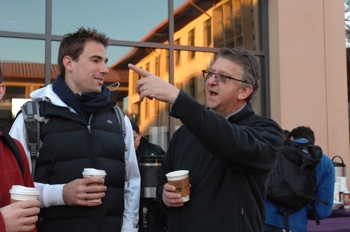
Stanford University Graduate School of Business Dean Garth Saloner said he expects the school to launch new programs for executives and managers as a result of the B-school’s new $345 million campus which had its official opening on Friday (April 29th).
In an interview with Poets&Quants, Saloner said the increased space now available to the B-school gives it much more room to increase its programming for executives and managers in Silicon Valley as well as graduate students in other Stanford University schools.
The new Knight Management Center, named after Nike founder and Stanford MBA alum Phil Knight, is a complex of eight new, separate buildings created around three quadrangles. Knight put up $105 million toward the cost of the new center. Together with a residential center, the B-school now has nine buildings versus four before. (See a slideshow of visual images of the new campus.)
The complex gives Stanford’s B-School some 360,000 square feet of space, roughly 30 percent more than it had in its previous location. There are now 13 tiered classrooms, up from 11, 20 flat-floored classrooms, up from eight, and 70 breakout and study rooms, a huge improvement from 28 previously. The larger number of breakout rooms, in particular, will help the school to more effectively deliver its new curriculum that emphasizes smaller greater collaboration and more seminar-style courses.
Despite the increased space, Saloner said there are no plans to increase the size of the school’s relatively small MBA program, which has an enrollment of just under 800 students—far below Harvard’s 1,840 or Wharton’s 1,687.
“We have room to grow,” says Saloner. “But we don’t have plans to grow the core MBA program at this time. It has nothing to do with space. It has to do with what we think is the special character of the program which relies on a degree of intimacy and personalization. And we just don’t want to mess with that basic formula.”
Instead, Saloner said the new facilities will allow the school to offer more executive education programming. Unlike several other schools, most notably Harvard, Northwestern, and Wharton, Stanford has been highly selective in deciding what executive education programs to offer. The school currently has about 24 different programs on the Stanford campus, though six of them are new, including a “Design Thinking Boot Camp” and “The Indispensable CTO: Strategic Leadership of Technology and Innovation.”
As a potential model for future growth, Saloner points to a new part-time program launched in January on innovation and entrepreneurship for both Silicon Valley professionals and university graduate students. The 20-week evening program, at a cost of $10,000 for participants outside Stanford, meets two evenings a week and one Saturday a month. Roughly half of the participants in the inaugural sessions are graduate students from the university’s medical, law and other schools.
“We can do more things like that,” Saloner says. “That’s really building bridges to the rest of Stanford University. We have a lot more capacity to open our doors to the rest of the university. It’s something, which the president has been driving for a decade and I am a big fan of. We are blessed because all seven schools are within walking distance of each other and we have a set of deans who are very collaborative. If you fast-forward a decade, you’re going to find that the schools will be less self-sufficient than they have been in the past.”
Saloner says he would like the business school to be as open and embracing of the wider university as Stanford’s Law School. Law School Dean Larry Kramer who has dramatically expanded joint degree programs as part of a multidisciplinary approach to legal studies. “He has completely opened the doors of the law school to the university,” says Saloner. “His view is that in the first year you teach your students to think like a lawyer, and then for the next two years, the university is law school. So they have much more of a fluid exchange with the rest of the university. This does give us the facilities to do lots of other things.”





Questions about this article? Email us or leave a comment below.